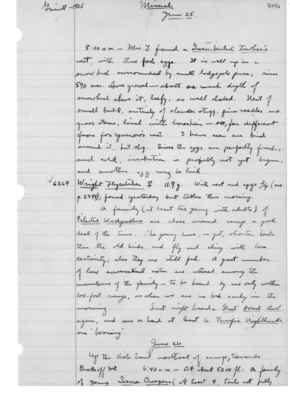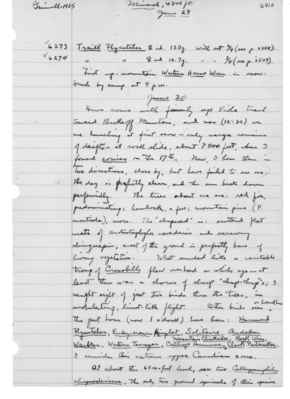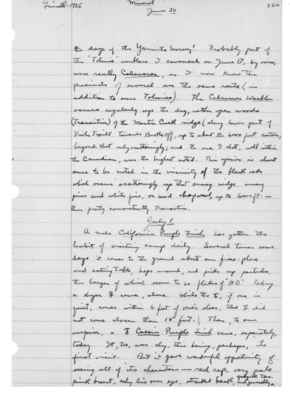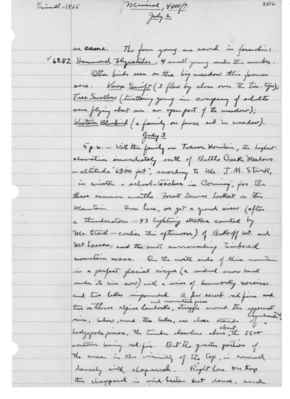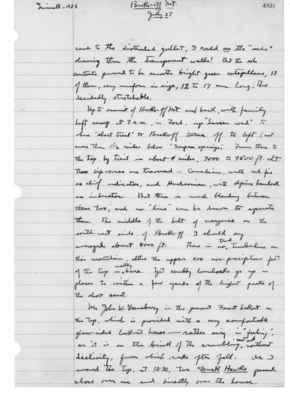Pages That Mention Brokeoff Mountain
1925: Joseph Grinnell's field notes
S2 Page 42
Collector: Grinnell - 1925 Location: Mineral Date: June 25 Page Number: 2496
8:00 a.m. - Mrs. G. found a Green-tailed Towhee's nest, with three fresh eggs. It is well up in a snow bush surrounded by small lodgepole pines; rim 590 mm. above ground - about as much depth of snowbush above it, leafy, so well shaded. Nest of small bulk, entirely of slender stuff, pine needles and grass stems, lined with horsehair - so, far different from fox sparrow's nest. I have seen one bird around it, but shy. Since the eggs are perfectly fresh, and cold, incubation is probably not yet begun, and another egg may be laid.
6264 Wright Flycatcher [female symbol] 11.9 g. With nest and eggs 3/4 (see p. 2494); found yesterday but taken this morning.
A family (at least two young with adults) of Pileated Woodpeckers are close around camp a good deal of the time. The young have, as yet, shorter tails than the old birds, and fly and cling with less certainty; also they are still fed. A great number of low conversational notes are uttered among the members of the family - to be heard by us only within 100-foot range, as when we are in bed early in the morning. Last night heard a Great Horned Owl again, and saw or heard at least 6 Pacific Nighthawks, one "booming".
June 26 Up the Vista Trail northeast of camp, towards Brokeoff Mt. 6:40 a.m. - At about 5200 ft.: A family of young Sierra Creepers (at least 4, tails not fully
S2 Page 57
Collector: Grinnell - 1925 Location: Mineral, 4800 ft. Date: June 29 Page Number: 2510
6273 Traill Flycatcher [female symbol] ad. 13.0 g. with set 3/4 (see p. 2508). 6274 Traill] [Flycatcher] [female symbol] ad. 12.7 g. [with] [set] 3/4 (see p. 2509).
First up - mountain Western House Wren in snow brush by camp at 4 p.m.
June 30 Have come with family up Viola trail towards Brokeoff Mountain, and now (12:30) we are lunching at first snow - only meagre remains of drifts - at rock slide, about 7500 feet, where I found conies on the 17th. Now, I hear them in two directions, close by, but have failed to see one. The day is perfectly clear, and the sun beats down perfervidly. The trees about me are: red fir, predominating; hemlock, a few; mountain pine (P. monticola), more. The "chaparral" is: scattered flat mats of arctostaphylos nevadensis and scrawny chinquapin; most of the ground is perfectly bare of living vegetation. What sounded like a veritable troup of Crossbills flew overhead a while ago - at least there was a chorus of sharp "chup-chup's"; I caught sight of just two birds thru the trees, in undulating, linnet-like flight. Other birds seen ^or heard here the past hour (now 1 o'clock) have been: Hammond Flycatcher, Ruby-crown Kinglet, Solitaire, Audubon Warbler, Western Tanager, Calliope Hummer,^ Mountain Chickadee, Rock Wren, Clark Nutcracker. I consider this extreme upper Canadian zone.
At about 6500-foot level, saw two Callospermophilus chrysodeirus, the only two ground squirrels of this species
S2 Page 59
Collector: Grinnell - 1925 Location: Mineral Date: June 30 Page Number: 2512
the days of the Yosemite Survey! Probably part of the "Tolmie" warblers I censused on June 17, by voice, were really Calaveras, as I now know the precincts of several over the same route (in addition to some Tolmies). The Calaveras Warbler occurs regular up the dry, rather open woods (Transition) of the Martin Creek ridge (along lower part of Viola Traill towards Brokeoff, up to about the 6000 foot contour; beyond that only scatteringly; and the one I shot, well within the Canadian, was the highest noted. This species is almost sure to be noted in the vicinity of the black oaks which occur scatteringly up that sunny ridge, among pines and white firs, or mid chaparral, up to 6000 ft. thus pretty consistently transitional.
July 1 A male California Purple Finch has gotten the habit of visiting camp daily. Several times some days it comes to the ground about our fire-place and eating table, hops around, and picks up particles, the larger of which seem to be flakes of "H O". Today a shyer [female symbol] came, alone. While the [male symbol], if one is quiet, comes within 6 feet of one's shoes, the [female symbol] did not come closer than 15 feet. \ Then, to our surprise, a [male symbol] Cassin Purple Finch came, separately, today. It, too, was shy, this being, perhaps, its first visit. But it gave wonderful opportunity of seeing all of its characters - red cap, very pale pink breast, ashy line over eye, streaked beak, and generally ^grayish tone.
S2 Page 63
Collector: Grinnell - 1925 Location: Mineral, 4800 ft. Date: July 2 Page Number: 2516
we came. The four young are saved in formalin: 6282 Hammond Flycatcher, 4 small young under this number.
Other birds seen on the big meadow this forenoon were: Vaux Swift (3 flew close over the tree-tops); Tree Swallow (twittering young in company of adults were flying about over the open part of the meadow); Western Bluebird (a family on fence and in meadow).
July 3 5 p.m. - With the family on Turner Mountain, the highest elevation immediately south of Battle Creek Meadows - altitude "6300 feet", according to Mr. J.M. Stark, in winter a school-teacher in Corning, for the three summer months Forest Service Lookout on this Mountain. From here, we get a grand view (after a thunderstorm - 43 lightning strikes counted by Mr. Stark - earlier this afternoon) of Brokeoff Mt. and Mt. Lassen, and the vast surrounding timbered mountain mass. On the north side of this mountain is a perfect glacial cirque (a residual snow bank under its rim now) with a series of hummocky moraines, and two lakes impounded. A few scrub red firs and two or three alpine hemlocks and mountain pines straggle around the uppermost rim; below, around the lakes, are close stands of hemlock and lodgepole pines, the timber elsewhere above about the 5500 contour being red-fir. But the greater portion of the area in the vicinity of the top, is covered densely with chaparral. Right here on top this chaparral is wind-beaten but dense, and
S2 Page 78
Collector: Grinnell - 1925 Location: Broke-off Mt. Date: July 27 Page Number: 2531
came to the distended gullet, I could see the "seeds" showing thru the transparent walls! But the sole contents proved to be smooth bright green caterpillars, 13 of them, very uniform in size, 12 to 17 mm. long, tho decidedly stretchable.
Up to summit of Broke-off Mt. and back, with family. Left camp at 7 a.m., in Ford, up "Lassen road" to where "short trail" to Broke-off turns off to left (not more than 1/2 miles below "Soupan springs." From there to the top by trail in about 4 miles, 7000 to 9500 ft. alt. two life-zones are traversed - Canadian, with red fir as chief indicated, and Hudsonian, with alpine hemlock as indicator. But there is much blending between these two, and no "line" can be drawn to separate them. The middle of the belt of mergence on the south-east side of Broke-off I should say averaged about 8000 ft. There is no true timberline on this mountain, altho [sic] the upper 400 non-precipitous feet of the top is mostly bare. Yet scrubby hemlocks go up in places to within a few yards of the brightest parts of the short crest.
Mr. John W. Gransbury is the present Forest Lookout on the top, which is provided with a very comfortable glass-sided lookout house - rather airy in "feeling", as it is on the brink of the crumbling ^east and northeast declivity, from which rocks often fall. As I waved the top, at 12:30, two Duck Hawks passed close over me and directly over the house.
